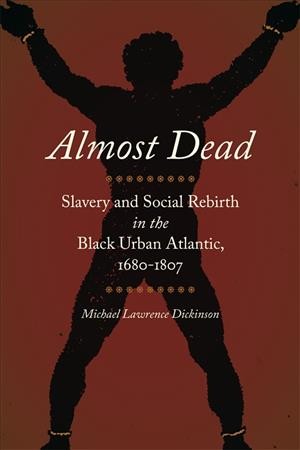The Book
Almost Dead: Slavery and Social Rebirth in the Black Urban Atlantic, 1680-1807
The Author(s)
Michael Lawrence Dickinson

In Almost Dead, Michael Dickinson looks to entwine the often-competing concepts of social death and cultural retention in port cities in the Atlantic world. The author chose urban areas as they “served an active role in shaping and being shaped by captives’ social processes” (pg. 2). To do so, Dickinson focuses on three English-speaking Atlantic ports, Bridgetown, Barbados, Kingston, Jamaica, and Philadelphia, Pennsylvania. The author explains that the Caribbean port-cities provide a view of enslaved life from the “capitals of the Anglo-Atlantic” while Philadelphia was not only “tied to the Greater Caribbean” through its economy but also “a city forged by enslaved labor and indebted to Black lives” (pg. 4). In choosing Philadelphia over other similar North American cities like Charleston, New York, or Boston, Dickinson wanted to “challenge traditional portraits of Philadelphia as a hub of Black freedom” (pg. 4).
Almost Dead is broken down into five chapters that trace the Black urban experience from capture in Africa to communal cultural retention in North America. In the first chapter, the author provides and overview of the processes of enslavement from initial seizure in the African interior to arrival in the Americas. Here, Dickinson makes the important point that though “captives already bore the harrowing journey,” “their sojourn through slavery was only beginning” (pg. 39).
In Chapter Two, Dickinson explains how this journey continued by exploring the movement of enslaved people between the three urban case studies, a “second leg of Atlantic dispersal [that] held its own horrors” (pg. 41). In doing so, Almost Dead reveals that cities worked very much like plantations as sites of commodification, yet “African identities could not be fundamentally erased” despite whites’ best efforts (pg. 60).
Chapter Three analyzes urban space to demonstrate how enslaved city life “reaffirm[ed] Black subjugation” (pg. 9). Through the lens of the punishments urban slaveholders meted out to their chattel, Dickinson argues that “slave codes and urban landscapes continued to remind captives of both their subjugation and the cost of disobedience” (pg. 84). And yet enslaved people’s “intellects could never be completely help captive,” thereby creating a subaltern community that discursively resisted their bondage (pg. 84).
The fourth chapter offers a spatial analysis of urban areas as “sites of collective expression for bondspeople” to show the “resiliency of West African cultures” (pg. 9-10). Here, Dickinson pushes past narratives of enslavement as labor to explain how social practices from Africa endured in the Americas. The author believes that “captive festivities across Anglo-American port cities underscored that the Black urban Atlantic not only was a setting for Black labor, it was the site of Black life, both physically and socially” (pg. 113).
The fifth chapter breaks down the mechanics of kinship communities that bondspeople created to withstand the emotional toll of enslavement. Dickinson points to these networks to show that “communities in port cities and throughout the Americas testified to the resilience of forced laborers” and that “while the institution worked to dehumanize captives, their humanity would remain intact” (pg. 138).
In a persuasively written epilogue, Dickinson projects his analysis of the eighteenth-century urban Black Atlantic into the present through conversation with the descendants of Jeffrey Brace, one of the enslaved people he tracked through the archives. The author urges readers to not only “do justice to populations and historical actors” but ensure those people “should also remain at the forefront of reconciling the lingering impact of the past with the present” (pg. 150). Almost Dead ultimately argues that for enslaved people, “social rebirth was their route to endurance” and that it was a “lived reality empowering African-descended peoples to survive slavery throughout the Black urban Atlantic and beyond” (pg. 11).
Most impressive about Almost Dead is Dickinson’s ability to parse out the urban enslaved experience in considerable detail. This is a product of considerable archival research on both sides of the Atlantic and allows Dickinson to weave engrossing narratives into his analysis. Similarly impressive is his use and choice of images that provide a richness to his evidence. Missing, however, is an acknowledgement of enslaved community building outside the English-speaking Atlantic. Though not part of the stated remit of the monograph, a mention of the huge and complex kinship networks that existed in, for example, Havana or Bahia, would have been helpful for strengthening the argument by making clear that this was not a phenomenon limited to the Anglo-Atlantic. Even so, Dickinson has written a carefully constructed book that should garner a wide readership among scholars of slavery in the Atlantic world and those interested in the origins of Black urban life in North America.
About the Reviewer
Lewis Eliot is an assistant professor of British Imperial history at the University of Oklahoma. He received his PhD from the University of South Carolina in 2021, MA from Queen’s University, Belfast in 2013, and BA from the School of Oriental & African Studies in 2012. He is currently working on a book manuscript entitled Neither Men nor Brothers: Rebellion and Empire in Britain’s Atlantic World that examines enslaved rebellions and the ways they informed abolitionism in Britain.

0